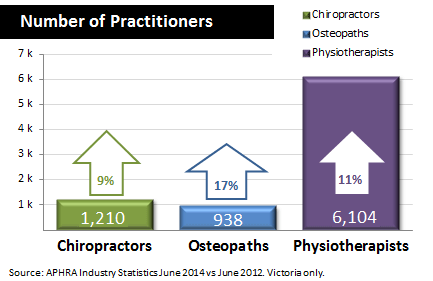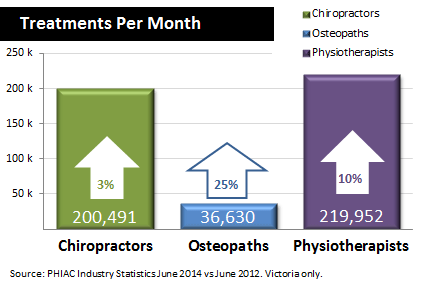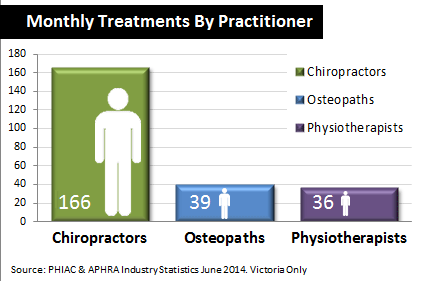 Ever wondered how many chiropractors, osteopaths and physiotherapists there are in Australia? It’s been about 2 years since I looked at the previous osteopathy growth rate. So I’ve taken stock and crunched the numbers and created helpful charts to compare total treatments and the growth rate for all practitioners. All while using official data sources.
Ever wondered how many chiropractors, osteopaths and physiotherapists there are in Australia? It’s been about 2 years since I looked at the previous osteopathy growth rate. So I’ve taken stock and crunched the numbers and created helpful charts to compare total treatments and the growth rate for all practitioners. All while using official data sources.
The Australian Health Practitioner Regulation Agency (AHPRA) is the national body responsible for regulating the accreditations of prominent health modalities (specialities).
And they keep records of the number of practising therapists.
As at June 2014, Australia has
- 4,577 registered practising chiropractors
- 1,791 registered practising osteopaths
- 25,093 registered practising physiotherapists.
Yes, that’s a lot of physios. Just remember that physios work across all hospitals, whereas chiropractors and osteopaths work in private clinics.
Chiropractors, Osteopaths and Physiotherapist Numbers in Victoria
Because Inlign Osteopathy is a Victorian clinic, we’re going to look at the numbers of manual therapists in Victoria. According to AHPRA, as at June 2014, Victoria has:
- 1,210 registered practicing chiropractors
- 938 registered practicing osteopaths
- 6,104 registered practicing physiotherapists.
By comparing the number of practitioners in June 2012 with the number in June 2014, we can determine which health profession is attracting the greatest percentage of growth.
From 2012-2014, the Victorian practitioner growth has been:
- 9% growth in chiropractors (from 1,114)
- 17% growth in osteopaths (from 801)
- 11% growth in physiotherapists (from 5,487)
I’m excited that the osteopath profession is attracting more growth than other manual therapies. A 17% growth rate is a solid endorsement that the next generation of health professionals sees the benefits of osteopathy.
The Number of Chiropractic, Osteopathic and Physiotherapy Treatments
The Private Health Insurance Administration Council (PHIAC) collects information on all the ancillary (extras) claims made by Australians with health insurance. This data provides an interesting snapshot into the usage of chiropractic, osteopathy and physiotherapy treatments.
Ofcourse, as this data only tallies treatments claimed under health insurance – the data shouldn’t be relied upon as the definitive total. But it is the best indicative resource available.
Based on these PHIAC statistics, from 2012-2014, the growth rate of Victorian treatments as been:
- 3% growth for chiropractic treatments (to 200,491 per month)
- 25% growth for osteopathic treatments (to 36,630 per month)
- 10% growth for physiotherapy treatments (to 219,952 per month)
The Average Number of Treatments Per Practitioner
If we divide the number of treatments by the number of practitioners, we can determine the average number of treatments each practitioner performs.
As at June 2014, the Victorian average treatments per practitioner were:
- An average chiropractor performed 166 chiropractic treatments per month
- An average osteopath performed 39 osteopathic treatments per month
- An average physiotherapist performed 36 physiotherapy sessions per month
It’s interesting that the osteopath and physiotherapy treatment average is on par, yet the average for chiropractic treatments is over 4 times higher. Hopefully Chiropractic patients are seeing the benefits of visiting their chiropractor mores often. As always, if you’re not seeing results from your practitioner, Inlign Osteopathy recommends that you try another recommended practitioner.
Another subtle development – in the last two years the average number of chiropractic treatments has fallen from 523 per practitioner (each 3 months) to 497 per practitioner per quarter – while the number of treatments by osteopaths and physiotherapists has remained stable.
This reduction in treatments could indicate that chiropractics are encouraging fewer treatments, or patients are opting for fewer treatments or their health insurance benefits are ending sooner.
All research compiled by Inlign Osteopathy.




